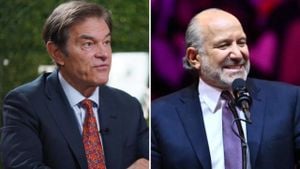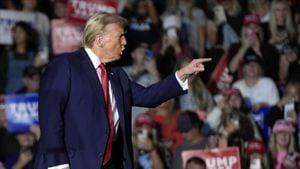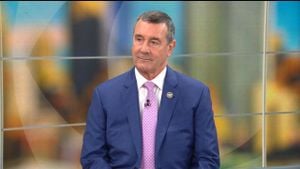On November 6, 2024, the United States witnessed yet another presidential election, one filled with emotions, speculations, and, most critically, contrasting outcomes. Donald Trump, the former president, was declared the winner of the 2024 election shortly after the polls closed. He enthusiastically claimed on social media and during his victory speech at the Palm Beach County Convention Center, “America has provided us with an unprecedented and powerful mandate.” Trump had initially boasted about crossing the 50% threshold for the popular vote, asserting he was on track for what he called “a political victory like our country has never seen before.”
Yet, the aftermath of the balloting presented a less glorious picture. Once tallies from across the nation were fully counted, Trump's claim of having received overwhelming popular support painted a much murkier portrait. Despite winning the electoral college, the reality was stark: Trump’s popular vote total has dramatically slipped below 50%. By the weekend following the election, as ballots continued to be counted particularly from the western states, his percentage hovered around 49.94%, with Kamala Harris trailing closely at 48.26%, as documented by the Cook Political Report.
This vote split indicates not just how close the election was but also shows Trump’s logistical advantage over Harris was not as secure as he initially presented. Historically speaking, only four past winners of American presidential elections have won with smaller popular vote margins than Trump's - which means his ``landslide'' victory narrative is now up for serious debate.
Despite maintaining his lead, Trump's popular-vote percentage continues to dip as final counts are completed across the country. This dwindling margin signifies the Democratic base's resilience, especially as Harris's numbers began to improve compared to her performance on election night. For Harris, her popular vote percentage is taking on significant historical weight. She now stands at levels higher than many recent major-party nominees, including Trump during his 2016 campaign, George W. Bush, and even Clinton.
The narrowing margin – just 1.68 percent between Trump and Harris – presents new questions about the dynamics of the Republican and Democratic parties as they head toward the new Congress slated to convene following the election. Interestingly, Trump's margin of victory would not cost him the presidency, but it does complicate the narrative surrounding his electoral mandate, emphasizing its fragility.
The excitement surrounding Trump’s narrative has been tempered by historical analysis, as his overall popular support is below Biden's, Obama’s, and even previous decades’ leading candidates. This development urges both Democrats and Republicans to critically examine their strategies and electoral approaches moving forward.
Simultaneously, the Democrats are now confronting the stark realities of the election outcomes across the nation. The results have led party members to convene and ponder over what went wrong, particularly focusing on Kamala Harris's campaign which many perceived did not resonate effectively with the electorate. The clear disconnect was felt at grassroots levels with members of the Wilkes University College Democrats club voicing disappointment during their post-election meeting days later.
During this gathering, club president Jace Hynick and vice president John Sudol highlighted the disconnection between the Democratic campaign messages and their target audience. They stressed their dedication to what they described as a “progressive charge” within the club's future initiatives. This sentiment reflects broader party discussions about maintaining relevancy and affecting positive societal change as they regroup for the future.
The members stressed the need for the party to realign its message, focusing on building stronger ties within communities and elevatory outreach programs. “Progressive change needs to come,” Sudol asserted, emphasizing the focus on educating and advocating for their core values.
Despite the dissonance felt within party ranks, there remains hope as the Democratic leadership contemplates reforming their tactics and policies to appeal to younger voters and working-class Americans who felt overlooked. An immediate call for community-building activities was proposed during the College Democrats' meeting, lightening the mood with plans for bracelet-making nights and trips to conventions aimed at renewing excitement among progressive youth.
The pearl of wisdom shared among club members reflects broader insights within the Democratic base: the fight isn't merely about the presidency. The groundwork must be laid for upcoming legislative sessions, particularly focusing on regaining congressional control by 2026. That fight for the working-class coalition is reigniting discussions about the impact of social issues and economic stability - two pivotal factors influencing the electorate today.
Analysts and political scientists are stressing the need for Democrats to mobilize grassroots efforts effectively. Julia Azari, political science associate professor, recently highlighted how legislative behavior often reflects perceived electoral mandates. Despite the tenuous narrative of Trump's mandate, her observations suggest legislators follow perceptions of voter approval within the broader spectrum.
This reflection on political actions showcases the underlying battle within the nation's political discourse, where narratives around electoral mandates hold significant sway over legislative priorities. While Trump’s electoral claims may attempt to paint his presidency as popular and supported, the numbers speak volumes about the divided sentiments across the country.
Looking forward, it remains unclear what the Trump administration's next steps will look like or how Democrats can adapt effectively to reclaim lost ground. The complexity of the political environment signifies challenges for both parties and emphasizes the need for innovation and strategic vision moving forward. For supporters and opponents alike, the elections only crystallized the importance of focusing on pressing issues like economic disparity, health care policies, and the nation’s overarching political climate.
With the final tallies still trickling out and party reflections deepening, it’s clear the road leading to the next presidential contest will be shaped by how both parties respond to the outcomes of the 2024 election. The takes on Trump's so-called mandate are already being dissected, with focus being paid not only to popular votes but the historical contexts shaping these election cycles



